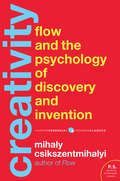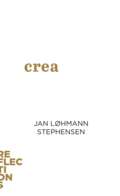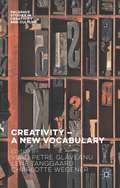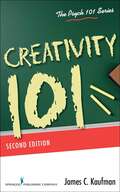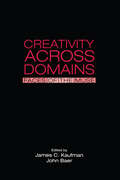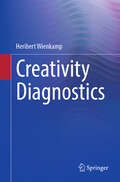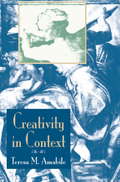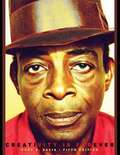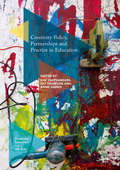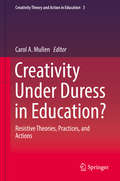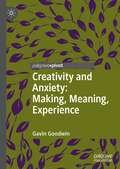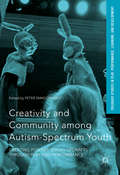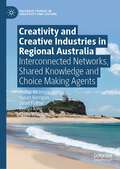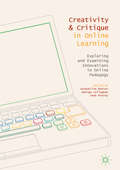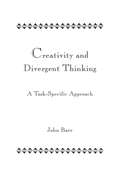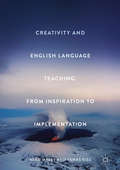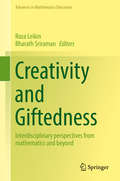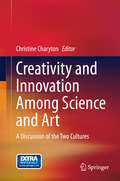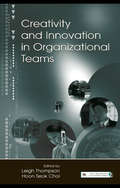- Table View
- List View
Creativity
by Mihaly CsikszentmihalyiCreativity is about capturing those moments that make life worth living. The author's objective is to offer an understanding of what leads to these moments, be it the excitement of the artist at the easel or the scientist in the lab, so that knowledge can be used to enrich people's lives. Drawing on 100 interviews with exceptional people, from biologists and physicists to politicians and business leaders, poets and artists, as well as his 30 years of research on the subject, Csikszentmihalyi uses his famous theory to explore the creative process. He discusses such ideas as why creative individuals are often seen as selfish and arrogant, and why the tortured genius is largely a myth. Most important, he clearly explains why creativity needs to be cultivated and is necessary for the future of our country, if not the world.
Creativity (Reflections)
by Jan Løhmann StephensenA short but engaging exploration of our changing perception of creativity.Creativity was once seen as the mark of mad geniuses, troubled souls, and avant-garde eccentrics. Today, however, we expect to find the trait thriving in and around us. Why? In Creativity, Jan Løhmann Stephensen provides a historical and contemporary view of creativity and explains why it is not always the answer to every problem. From van Gogh to Springsteen, Løhmann Stephensen explores the creative process of artists in order to craft a new theory of creativity—marking it as a collective and dynamic process in flux, rather than a finished product with a set endpoint and sole creator. Finally, he warns, in the twenty-first century, the importance that employers place on creativity has warped the concept into a ubiquitous economic commodity.ReflectionsIn Reflections, a series copublished with Denmark's Aarhus University Press, scholars deliver 60-page reflections on a key concept that encapsulates their years of study and research. These books present unique insights on a wide range of topics and concepts—everything from love, trust, and play to corruption, welfare, and sleep—that entertain and enlighten readers with exciting discoveries and new perspectives.
Creativity - A New Vocabulary (Palgrave Studies in Creativity and Culture)
by Lene Tanggaard Charlotte Wegener Vlad GlaveanuThis book covers topics not commonly associated with creativity that offer us insight into creative action as a social, material, and cultural process. A wide range of specialists within the humanities and social sciences will find this interesting, as well as practitioners who are looking for novel ways of thinking about and doing creative work.
Creativity 101 (Psych 101)
by James C. KaufmanCreativity 101, describes the history of how people began to study creativity and discusses different definitions. It explores the "Four P's" (person, process, product, and press).
Creativity 101 (The Psych 101 Series)
by James C. KaufmanWhat is creativity? How does it work? How does it flourish in individuals and organizations? Now in its second edition, this bestselling introductory text--written by one of the worlds leading experts on the psychology of creativity--is completely updated and expanded to reflect the tremendous growth in this field. In a redesigned, reader-friendly format, the text surveys the latest theories and research to provide key information about what we know (and don't know) about creativity including its many definitions and measures. It addresses how creativity operates on individual and social/environmental levels, and the effects and outcomes of the creative mind
Creativity Across Domains: Faces of the Muse
by James C. Kaufman John BaerCreativity Across Domains: Faces of the Muse sorts through the sometimes-confusing theoretical diversity that domain specificity has spawned. It also brings together writers who have studied creative thinkers in different areas, such as the various arts, sciences, and communication/leadership. Each contributor explains what is known about the cognitive processes, ways of conceptualizing and solving problems, personality and motivational attributes, guiding metaphors, and work habits or styles that best characterize creative people within the domain he or she has investigated. In addition, this book features: *an examination of how creativity is similar and different in diverse domains; *chapters written by an expert on creativity in the domain about which he or she is writing; *a chapter on creativity in psychology which examines patterns of performance leading to creative eminence in different areas of psychology; and *a final chapter proposing a new theory of creativity--the Amusement Park Theoretical Model. This book appeals to creativity researchers and students of creativity; cognitive, education, social, and developmental psychologists; and educated laypeople interested in exploring their own creativity.
Creativity Diagnostics
by Heribert WienkampCreativity diagnostics is actually paradoxical and “an impossible task.” It is neither plannable nor retrievable on demand, nor can it be prescribed with the motto: “Be spontaneous” or “Be creative!” All previous attempts to assess creative performance or behavior, for example through creativity tests using the criteria of “idea richness” and “idea diversity” under formal standardization rules (e.g. time limits) and norms, have mostly failed to meet expectations, whether in schools or in corporate aptitude diagnostics. At best, creativity could be demonstrated in the artistic-scientific field through work samples or “brilliant inventions.” In day-to-day operations and workplaces, creativity is typically observable over a longer period, taking into account its usefulness and social acceptance. What “approaches” might be possible in psychological diagnostics to assess creativity, and what limitations they are subject to, is the topic of this “creative” article. Target groups Psychologists and HR experts in both academia and practice, as well as school educators and HR managers responsible for evaluating the creative performance of their employees.
Creativity In Context
by Teresa M AmabileAn update of the author's 1983 work, , retaining the original edition's preface, ten chapters, and references, with updates after each chapter. Material in the original chapters that gets expanded treatment in the updates is marked by a symbol. The updates review major changes in theory and research in the field of creativity, focusing on the ways creativity can be killed or encouraged by social-psychological influences. For students, researchers, and general readers. Annotation c. by Book News, Inc. , Portland, Or.
Creativity In Context
by Teresa M AmabileCreativity in Context is an update of The Social Psychology of Creativity, a classic text for researchers, students, and other interested readers. Creativity in Context incorporates extensive new material, going far beyond the original to provide a comprehensive picture of how the motivation for creative behavior, and creativity itself, can be influenced by the social environment. Teresa Amabile describes new findings from both her own research and from the work of many others in the field, detailing not only the ways in which creativity can be killed by social-psychological influences, but also the ways in which it can be maintained and stimulated. The research and the theory have moved beyond a narrow focus on the immediate social environment to a consideration of broad social influences in business organizations, classrooms, and society at large; beyond a documentation of social influences to a consideration of the cognitive mechanisms by which social factors might impact creativity; and beyond subject populations consisting of children and college students to an inclusion of professional artists, research scientists, and other working adults. Amabile describes a greatly expanded set of methodologies for assessing creativity, and introduces a set of methodologies for assessing the social environment for creativity in non-experimental studies. Throughout, the book maintains a clear focus on a comprehensive view of creativity--how the social context can influence motivation and how motivation, in conjunction with personal skills and thinking styles, can lead to the expression of creative behavior within that context. The result is a clarified theory of how creativity actually happens, with strong implications for supporting and increasing essential aspects of human performance.
Creativity In Context
by Teresa M AmabileCreativity in Context is an update of The Social Psychology of Creativity, a classic text for researchers, students, and other interested readers. Creativity in Context incorporates extensive new material, going far beyond the original to provide a comprehensive picture of how the motivation for creative behavior, and creativity itself, can be influenced by the social environment.Teresa Amabile describes new findings from both her own research and from the work of many others in the field, detailing not only the ways in which creativity can be killed by social-psychological influences, but also the ways in which it can be maintained and stimulated. The research and the theory have moved beyond a narrow focus on the immediate social environment to a consideration of broad social influences in business organizations, classrooms, and society at large; beyond a documentation of social influences to a consideration of the cognitive mechanisms by which social factors might impact creativity; and beyond subject populations consisting of children and college students to an inclusion of professional artists, research scientists, and other working adults.Amabile describes a greatly expanded set of methodologies for assessing creativity, and introduces a set of methodologies for assessing the social environment for creativity in non-experimental studies. Throughout, the book maintains a clear focus on a comprehensive view of creativity-how the social context can influence motivation and how motivation, in conjunction with personal skills and thinking styles, can lead to the expression of creative behavior within that context. The result is a clarified theory of how creativity actually happens, with strong implications for supporting and increasing essential aspects of human performance.
Creativity In Context: Update To The Social Psychology Of Creativity
by Teresa M AmabileThis book preserves the original content and provides some insight into recent developments in the social psychology of creativity. It begins to study the ways in which social factors can serve to maintain creativity and cognitive mechanisms by which motivation might have an impact on creativity.
Creativity Is Forever (5th edition)
by Gary A. DavisThis book was prepared for any adult interested in better understanding the topic of creativity, becoming a more creative person, or teaching others to think more creatively. It is true that much about human creativity remains---and will remain---an intriguing mystery. It is difficult indeed to untangle the drives, thoughts images, and inspirations of a Thomas Edison, Georgia O'Keeffe, or Walt Disney. As we will see in Chapter 3, extraordinarily creative people have not understood their own creativeness. However, it also is absolutely true that we do understand much about creativity and creative people---their energetic and curious personalities, their ideas--finding processes and strategies, and the circumstances that support or squelch their lively imaginations and innovative thinking.
Creativity Policy, Partnerships and Practice in Education (Creativity, Education and the Arts)
by Pat Thomson Anne Harris Kim SnepvangersThis book examines the gaps in creativity education across the education lifespan and the resulting implications for creative education and economic policy. Building on cutting-edge international research, the editors and contributors explore innovations in interdisciplinary creativities, including STEM agendas and definitions, science and creativity and organisational creativity amongst other subjects. Central to the volume is the idea that good creative educational practice and policy advancement needs to reimagine individual contribution and possibilities, whilst resisting standardization: it is inherently risky, not risk-averse. Prioritising creative partnerships, zones of contact, practice encounters and creative ecologies signal new modes of participatory engagement. Unfortunately, while primary schools continue to construct environments conducive to this kind of ‘slow education’, secondary schools and education policy persistently do not. This book argues, from diverse viewpoints and methodological perspectives, that 21st-century creativity education must find a way to advance in a more integrated and less siloed manner in order to respond to pedagogical innovation, economic imperatives and creative possibilities, and adequately prepare students for creative practice, workplaces and publics. This innovative volume will appeal to students and scholars of creative practice as well as policy makers and practitioners.
Creativity Under Duress in Education?: Resistive Theories, Practices, and Actions (Creativity Theory and Action in Education #3)
by Carol A. MullenCreativity Under Duress in Education? introduces a new framework—creativity under duress in education. Leading creativity researchers and educational scholars discuss creative theory and practice from an educational lens that is provocative. Across international contexts, this book combines insights from creativity and educational research; rich illustrations from classrooms, schools, and other professional settings, and practical ideas and strategies for how anyone invested in education can support creative teaching and learning. Readers will encounter diverse perspectives from an international cast of authors exploring cutting-edge ideas for creativity and innovation as a foremost priority for economies in the new millennium. At the same time, they consider forces of authority, control, and constraint that impact creative education and innovation within educational systems, extending to the professions. Educators and those interested in the future of education are vitally important to this conversation around research-based and practical analyses of creativity in and beyond the classroom. Addressed are these major issues: (1) creativity frameworks of theory and action in education, (2) research investigations into creativity and education, and (3) applications of creativity theory in real-world practice.Dynamic, this book presents a bridge between draconian contexts of assessment and explosive creativity in diverse places. A key contribution of the volume is its validation and promotion of creativity and innovation for students, teachers, professors, leaders, employers, policymakers, and others seeking ways to profoundly improve learning and transform education. In tackling the seemingly irreconcilable issues of creativity and accountability in K–12 institutions, higher education, and policy circles, worldwide, this work offers a message that is both cautionary and inspiring. Book editor Carol A. Mullen, PhD, is Professor of Educational Leadership at Virginia Tech, Virginia, USA. A twice-awarded Fulbright Scholar to China (2015) and Canada (2017), she was honored with the 2016 Jay D. Scribner Mentoring Award from the University Council for Educational Administration. She is author of Creativity and Education in China (2017) and co-editor of Education policy perils (2016).
Creativity and Anxiety: Making, Meaning, Experience (Palgrave Studies in Creativity and Culture)
by Gavin GoodwinAnxiety is perhaps the defining psychological malady of our age, whereas creativity is seen as an almost unassailable good, its importance heralded and promoted in a range of disciplines and domains. A number of diverse thinkers and researchers have tried to unpick the relationship between anxiety and creativity, and this short book explores and connects some of their ideas and findings. Drawing on psychoanalysis and neuroscience, existential psychology and mindfulness, literary studies and philosophy, this book places a range of different disciplines in dialogue. It explores how creativity and anxiety might impact one another, and argues for the importance of establishing a diverse and inclusive cultural space which everyone can draw from and contribute to.
Creativity and Communication in Persons with Dementia
by Claire Craig John KillickProviding people with dementia with opportunities to engage in creative activity can play a crucial role in maintaining and enhancing communication, and in reinforcing personhood and identity. This thoughtful book describes how people with dementia, and the people who work with and care for them, can foster and develop a creative approach, and provides rich and varied ideas for creative activities. The authors explore the concept of creativity - what exactly it is, its particular relevance for people with dementia and how to get into the creative 'flow'. They introduce a range of creative art forms, including poetry and story-telling, collage, drama, music-making, photography, textiles and working with wood and metal, and suggest possibilities for employing them in a range of settings, and with people of all abilities. Consideration is given to the practicalities of facilitating such creative work, including how to organise and run sessions, how to involve people with dementia and their carers, and how to reflect upon the experience. Practice examples are included throughout the book, as well as the comments and observations of people with dementia, and many examples of the artwork and poetry the authors have created with people with dementia over the years. Brimming with ideas, suggestions and helpful guidance, this is an essential resource for all those who work with people with dementia, and an inspiring read for people with dementia and their families.
Creativity and Community among Autism-Spectrum Youth: Creating Positive Social Updrafts through Play and Performance (Palgrave Studies In Play, Performance, Learning, and Development)
by Peter SmagorinskyThis edited volume explores the roles of socially-channeled play and performance in the developmental trajectories of young people who fall on the autism spectrum. The contributors offer possibilities for channels of activity through which youth on the autism spectrum may find acceptance, affirmation, and kinship with others. "Positive social updraft" characterizes the social channels through which people of difference might be swept up into broader cultural currents such that they feel valued, appreciated, and empowered. A social updraft provides cultural meditational means that include people in a current headed "upward," allowing people of atypical makeups to become fully involved in significant cultural activity that brings them a feeling of social belonging.
Creativity and Creative Industries in Regional Australia: Interconnected Networks, Shared Knowledge and Choice Making Agents (Palgrave Studies in Creativity and Culture)
by Susan Kerrigan Phillip McIntyre Janet Fulton Claire Williams Evelyn KingThis book explores the relationship between creativity, creative people, and creative industries in regional Australia through examining lived experience. The authors draw on more than 100 qualitative interviews with creative workers, and contextualise this creative work within the broader social and cultural structures of Australia’s Hunter region (located north of Sydney, in New South Wales). An invaluable resource for anyone interested in creative ecosystems as well as creativity and innovation, this book is an ethnographic study using the Hunter region as a case connected to the national and global networks that typify the creative industry. This timely addition to the Palgrave Studies in Creativity and Culture series gives a unique insight into creativity and cultural production.
Creativity and Crime
by David H. Cropley Arthur J. CropleyCreativity is typically perceived to be a positive, constructive attribute and yet, highly effective, novel crimes are committed which illustrate that creativity can also be utilized to serve a darker and more destructive end. But how can these 'creative criminals' be stopped? Adopting a psychological approach, renowned subject experts Cropley and Cropley draw upon concepts such as 'Person,' 'Process', 'Press' and 'Product' to explain how existing psychological theories of creativity can be applied to a more subtle subset of ingenuity; that is to say criminal behaviour and its consequences. Creativity and Crime does not look at felony involving impulsive, reflexive or merely deviant behaviour, but rather the novel and resourceful measures employed by criminals to more effectively achieve their lawbreaking goals. The book transcends the link between crime and creativity, and proposes a range of preventative measures for law enforcers. Scholars and graduates alike will find this an invaluable and illuminating read.
Creativity and Critique in Online Learning: Exploring and Examining Innovations in Online Pedagogy
by Jacqueline Baxter George Callaghan Jean McAvoyThis book explores emerging practices in distance education that have been facilitated by the development of educational technology. The volume examines core themes in distance education including online education at scale, embodiment in online environments, connectivity in online education and the personalisation of learning experiences within online education. The first section of the book examines online teaching tools, and explores how they are being used to enhance and promote student learning. The second looks at some of the broader challenges encountered by online teachers and those responsible for designing online learning material. While this volume will be of significant interest to distance learning universities and colleges, it will also be a valuable resource to traditional Higher Education Institutions, who are increasingly searching for innovative ways to reach and teach their students. This edited collection will be of value to scholars of online education as well as practitioners and policy makers looking to enrich their notions of online pedagogy.
Creativity and Divergent Thinking: A Task-Specific Approach
by John BaerDo general-purpose creative-thinking skills -- skills like divergent thinking, which is touted as an important component of creative thinking no matter what the task domain -- actually make much of a contribution to creative performance? Although much recent research argues against such domain-transcending skills -- including several new studies reported in this book -- the appeal of such general skills remains strong, probably because of the theoretical economy and power such skills would provide. Divergent thinking, in particular, has had an incredible staying power. Despite its many flaws, divergent thinking remains the most frequently used indicator of creativity in both creativity research and educational practice, and divergent thinking theory has a strong hold on everyday conceptions of what it means to be creative. Reviewing the available research on divergent thinking, this book presents a framework for understanding other major theories of creativity, including Mednick's associative theory and a possible connectionist approach of creativity. It reports a series of studies (including the study that won APA's 1992 Berlyne Prize) that demonstrate the absence of effects of general creative-thinking skills across a range of creativity-relevant tasks, but indicate that training in divergent thinking does in fact improve creative performance across diverse task domains. The book then ties these findings together with a multi-level theory, in which a task-specific approach to creativity is strengthened by recasting some divergent-thinking concepts into domain- and task-specific forms. This book fills the gap between divergent-thinking theory and more recent, modular conceptions of creativity. Rather than advocate that we simply discard divergent thinking -- an approach that hasn't worked, or at least hasn't happened, because of many attacks on its validity and usefulness -- this book shows how to separate what is useful in divergent-thinking theory and practice from what is not. It shows that divergent-thinking training can be valuable, although often not for the reasons trainers think it works. And it offers specific suggestions about the kinds of creativity research most needed today.
Creativity and English Language Teaching: From Inspiration to Implementation
by Alan Maley Tamas KissThis book offers a unique perspective on creativity in an educational environment where there is a relative dearth of literature on this subject. The authors link practice and principle to provide a practical and valuable guide for more creative language learning and teaching, using not only theoretical ideas but useful practical advice and recommendations on how better to introduce creativity into teaching and daily life. This innovative volume is sure to become a crucial reference point for teachers and practitioners of language teaching, and anyone interested in the ways in which creativity can be channelled into the teaching and learning process.
Creativity and Giftedness: Interdisciplinary perspectives from mathematics and beyond (Advances in Mathematics Education #6)
by Roza Leikin Bharath SriramanThis volume provides readers with a broad view on the variety of issues related to the educational research and practices in the field of Creativity in Mathematics and Mathematical Giftedness. The book explores (a) the relationship between creativity and giftedness; (b) empirical work with high ability (or gifted) students in the classroom and its implications for teaching mathematics; (c) interdisciplinary work which views creativity as a complex phenomena that cannot be understood from within the borders of disciplines, i. e. , to present research and theorists from disciplines such as neuroscience and complexity theory; and (d) findings from psychology that pertain the creatively gifted students. As a whole, this volume brings together perspectives from mathematics educators, psychologists, neuroscientists, and teachers to present a collection of empirical, theoretical and philosophical works that address the complexity of mathematical creativity and giftedness, its origins, nature, nurture and ways forward. In keeping with the spirit of the series, the anthology substantially builds on previous ZDM volumes on interdisciplinarity (2009), creativity and giftedness (2013).
Creativity and Innovation Among Science and Art: A Discussion of the Two Cultures
by Christine CharytonThis edited book will address creativity and innovation among the two cultures of science and art. Disciplines within science and art include: medicine (neurology), music therapy, art therapy, physics, chemistry, engineering, music, improvisation, education and aesthetics. This book will be the first of its kind to appeal to a broad audience of students, scholars, scientists, professionals, practitioners (physicians, psychologists, counsellors and social workers), musicians, artists, educators and administrators. In order to understand creativity and innovation across fields, the approach is multidisciplinary. While there is overlap across disciplines, unique domain specific traits exist in each field and are also discussed in addition to similarities. This book engages the reader with the comparison of similarities and differences through dialog across disciplines. Authors of each chapter address creativity and innovation from their own distinct perspective. Each chapter is transdisciplinary in approach. These perspectives entail a representation of their field through research, teaching, service and/or practice.
Creativity and Innovation in Organizational Teams (Organization and Management Series)
by Leigh L. Thompson Hoon-Seok ChoiCreativity and Innovation in Organizational Teams stemmed from a conference held at the Kellogg School of Management in June 2003 covering creativity and innovation in groups and organizations. Each chapter of the book is written by an expert and covers original theory about creative processes in organizations. The organization of the text reflects a longstanding notion that creativity in the world of work is a joint outcome of three interdependent forces--individual thinking, group processes, and organizational environment.Part I explores basic cognitive mechanisms that underlie creative thinking, and includes chapters that discuss cognitive foundations of creativity, a cognitive network model of creativity that explains how and why creative solutions form in the human mind, and imports a ground-breaking concept of "creativity templates" to the study of creative idea generation in negotiation context. The second part is devoted to understanding how groups and teams in organizational settings produce creative ideas and implement innovations. Finally, Part III contains three chapters that discuss the role of social, organizational context in which creative endeavors take place.The book has a strong international mix of scholarship and includes clear business implications based on scientific research. It weds the disciplines of psychology, cognition, and business theory into one text.
